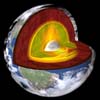| . |  |
. |
One of the first global-scale simulations of dust and climate from preindustrial times to the year 2100 projects a worldwide decrease in airborne dust of 20�63% by the end of this century. The computer model studies show less wind, more moisture, and enhanced vegetation in desert areas as carbon dioxide increases over the next century, keeping more of the world's dust on the ground. Coauthor Natalie Mahowald of the National Center for Atmospheric Research presented the results this week at the American Geophysical Union's annual meeting in San Francisco. "Reductions in global dust levels could have a profound impact on future climate predictions," says Mahowald. Dust helps to lower global temperature by reflecting sunlight, as well as by depositing iron in the ocean and thus fertilizing marine organisms that remove carbon dioxide from the atmosphere. Mahowald and Chao Luo (University of California, Santa Barbara) combined NCAR's global Climate System Model with other software specifically tailored to simulate dust under a variety of climate regimes. The climate changes are driven primarily by an increase in atmospheric carbon dioxide from 280 parts per million in 1890 (preindustrial) to 500 ppm by 2090--a scenario considered reasonable by the Intergovernmental Panel on Climate Change. The NCAR simulation shows decreasing winds and increasing moisture across arid, low-lying regions such as the Sahara, which produce much of the world's dust. It also includes the process through which a gradual increase in atmospheric carbon dioxide may stimulate photosynthesis of plants in arid regions, which in turn would reduce the extent of unvegetated areas and the dust they produce. Mahowald and Luo examined six different scenarios for the interaction of plants and climate across each of three decades: 1880�1889 (preindustrial), 1990-1999, and 2090�2099. For the six scenarios, the decrease in extent of desert dust sources in 2090�2099 compared to 1990�1999 ranges from 0 to 39 percent. The decrease in how much dust gets entrained into the atmosphere is even more dramatic: from 20 to 63 percent, depending on the scenario. The wide variation among scenarios highlights the uncertainty in this new area of research, says Mahowald. She believes that climate assessments such as those from the Intergovernmental Panel on Climate Change may be underestimating both the magnitude and the uncertainty of dust's global impact on climate. "There is substantial spread in the model projections for climate close to large arid regions such as the Sahel," says Mahowald. "It is very difficult to predict whether particular regions will get wetter or drier." Related LinksSpaceDaily Search SpaceDaily Subscribe To SpaceDaily Express  Princeton - Dec 08, 2003
Princeton - Dec 08, 2003Like doctors taking a sonogram of a human body, Princeton geoscientists have captured images of the interior of the Earth and revealed structures that help explain how the planet changes and ages.
|
| ||||||||||
| The content herein, unless otherwise known to be public domain, are Copyright 1995-2016 - Space Media Network. All websites are published in Australia and are solely subject to Australian law and governed by Fair Use principals for news reporting and research purposes. AFP, UPI and IANS news wire stories are copyright Agence France-Presse, United Press International and Indo-Asia News Service. ESA news reports are copyright European Space Agency. All NASA sourced material is public domain. Additional copyrights may apply in whole or part to other bona fide parties. Advertising does not imply endorsement, agreement or approval of any opinions, statements or information provided by Space Media Network on any Web page published or hosted by Space Media Network. Privacy Statement All images and articles appearing on Space Media Network have been edited or digitally altered in some way. Any requests to remove copyright material will be acted upon in a timely and appropriate manner. Any attempt to extort money from Space Media Network will be ignored and reported to Australian Law Enforcement Agencies as a potential case of financial fraud involving the use of a telephonic carriage device or postal service. |